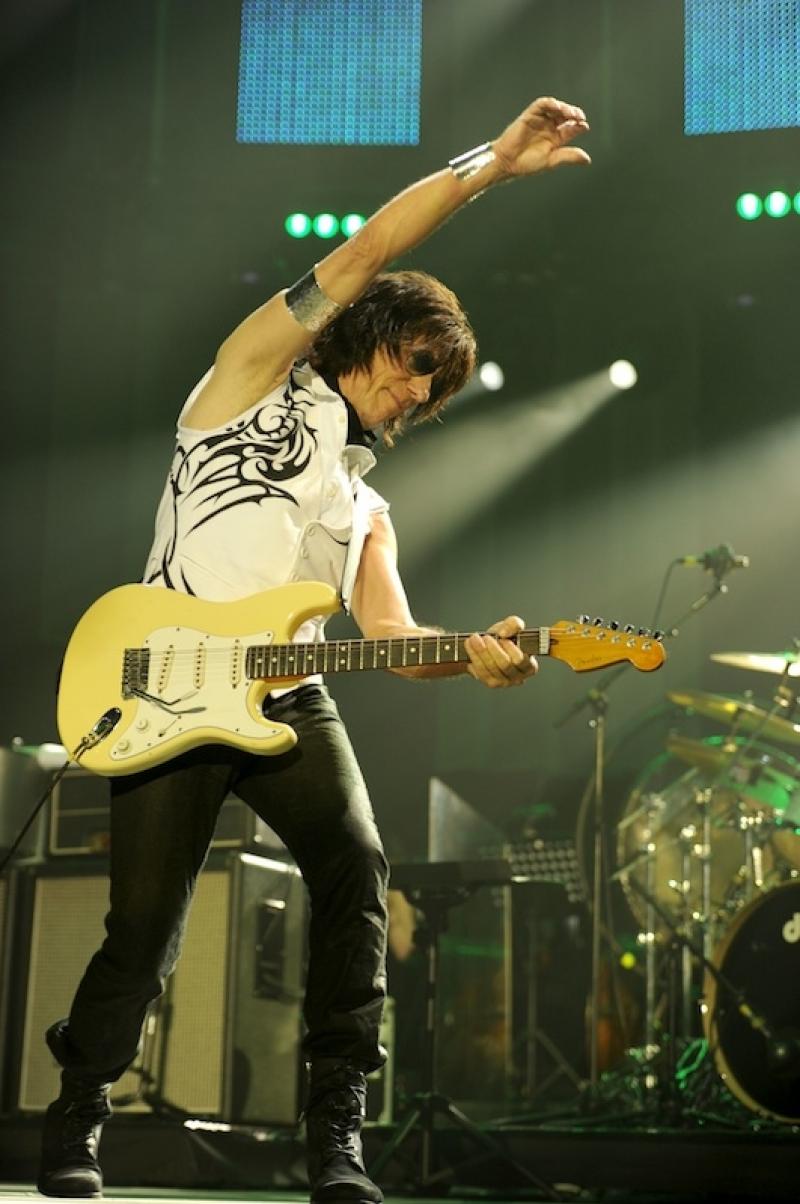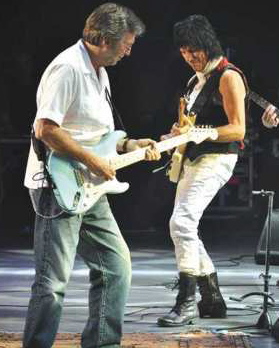Jeff Beck and Eric Clapton, O2 Arena | reviews, news & interviews
Jeff Beck and Eric Clapton, O2 Arena
Jeff Beck and Eric Clapton, O2 Arena
British guitar legends reunite to rock the O2

Along with the compact disc and record company profits, the Guitar Hero has become virtually extinct in the modern era. Thus, finding two gilt-edged specimens of this increasingly scarce breed sharing a stage is gold dust indeed. Both of them have been drenched in accolades, Jeff Beck having been inducted into the Rock and Roll Hall of Fame twice and Eric Clapton three times.
Beck replaced Clapton in the Yardbirds in 1965 after "God" decided that the group were becoming too commercial and un-bluesy, but while Clapton has remained stubbornly true to his blues calling over the decades, Beck has evolved in all kinds of directions. His CV encompasses hard rock, jazz-rock fusion and even a bespoke version of classical crossover, while his technical prowess on his instrument continues to trample new frontiers.
Thus, the individual sets played by each of them presented two dramatically different musicians. Beck, still looking trim and gunslinger-ish at 65 (though his luxuriant head of jet-black hair must inevitably arouse suspicion), was accompanied by a fiery and versatile trio comprising bassist Rhonda Smith, keyboards whizz Jason Rebello and the massively authoritative drummer Narada Michael Walden, as well as a platoon of string players. Not that there was any doubt that Beck was in charge, as he blitzed the cavernous O2 with the machine-gun riffs of "Led Boots", the complex funk-rock of "Hammerhead" (one of several tracks from his forthcoming album, Emotion & Commotion) or the crunching rhythms of "Big Block".
But, armed with an intricate thumb and finger technique, he explored a variety of contrasting textures too. For the Celtic-influenced "Mna Na" he was joined by Sharon Corr on violin, adjusting the touch and tone of his guitar playing accordingly. His delicate instrumental arrangement of Curtis Mayfield's "People Get Ready" was as evocative as it was brief, while "There's No Other Me" gave a barefoot Joss Stone an opportunity to unleash her inner soul diva with impressive force. They followed that with a version of "I Put A Spell On You", Stone smouldering her way through the lyric while band and string section surged beneath her. Beck wrapped up his set with an arrangement of the Beatles' "A Day in the Life", a riot of mood-changes, swirling strings and tumultuous chords, especially the one that put the full stop on the end (Clapton and Beck, pictured below).
 Clapton, on the other hand, played a batch of songs that have been at the core of his repertoire for years, but with an unmistakeable sense of purpose. It was Keith Richards who once commented that Eric can sometimes use a motivational boot up the backside, and sharing a bill with the on-form Beck may have given him just that.
Clapton, on the other hand, played a batch of songs that have been at the core of his repertoire for years, but with an unmistakeable sense of purpose. It was Keith Richards who once commented that Eric can sometimes use a motivational boot up the backside, and sharing a bill with the on-form Beck may have given him just that.
He warmed up with some acoustic pieces, though why he thinks "Layla" works as slowed-down easy listening remains unfathomable, before picking up a blue Stratocaster and cutting loose on a storming "Tell the Truth".
Sometimes he plays it fast, but this was the slower version, giving him space to alternate between piercing solos and fat, crunchy rhythm chords. A taut and focused "Key to the Highway" followed, given an extra boost by his pair of female backing singers. He launched "I Shot the Sheriff" with an extended guitar introduction as the band generated a tough reggae groove, miles removed from Clapton's laid-back original recording. They dropped back for Clapton's pivotal solo, which allowed him to rebuild the pressure towards a final crescendo. Sadly, he spoiled some of the good work with the mawkish "Wonderful Tonight", before galloping to the finishing tape with "Cocaine" and "Crossroads".
After all this, it wasn't much of a surprise that the pair's joint final set was somewhat anti-climactic, as they traded barrages of soloing across a selection of mostly traditional blues pieces (and a schlocky "Moon River", crooned winsomely by Clapton). Beck's hyper-technical fretwork and deft use of the tremolo arm contrasted with Clapton's more traditional approach, which merely emphasised that despite some shared history, these two have never been pursuing the same objectives.
Add comment
The future of Arts Journalism
You can stop theartsdesk.com closing!
We urgently need financing to survive. Our fundraising drive has thus far raised £49,000 but we need to reach £100,000 or we will be forced to close. Please contribute here: https://gofund.me/c3f6033d
And if you can forward this information to anyone who might assist, we’d be grateful.

Subscribe to theartsdesk.com
Thank you for continuing to read our work on theartsdesk.com. For unlimited access to every article in its entirety, including our archive of more than 15,000 pieces, we're asking for £5 per month or £40 per year. We feel it's a very good deal, and hope you do too.
To take a subscription now simply click here.
And if you're looking for that extra gift for a friend or family member, why not treat them to a theartsdesk.com gift subscription?
more New music
 Music Reissues Weekly: Sly and the Family Stone - The First Family: Live At Winchester Cathedral 1967
Must-have, first-ever release of the earliest document of the legendary soul outfit
Music Reissues Weekly: Sly and the Family Stone - The First Family: Live At Winchester Cathedral 1967
Must-have, first-ever release of the earliest document of the legendary soul outfit
 Album: Robert Plant - Saving Grace
Mellow delight from former Zep lead
Album: Robert Plant - Saving Grace
Mellow delight from former Zep lead
 Brìghde Chaimbeul, Round Chapel review - enchantment in East London
Inscrutable purveyor of experimental Celtic music summons creepiness and intensity
Brìghde Chaimbeul, Round Chapel review - enchantment in East London
Inscrutable purveyor of experimental Celtic music summons creepiness and intensity
 First Person: Musician ALA.NI on how thoughts of empire and reparation influenced a song
She usually sings about affairs of the heart - 'TIEF' is different, explains the star
First Person: Musician ALA.NI on how thoughts of empire and reparation influenced a song
She usually sings about affairs of the heart - 'TIEF' is different, explains the star
 Album: NewDad - Altar
The hard-gigging trio yearns for old Ireland – and blasts music biz exploitation
Album: NewDad - Altar
The hard-gigging trio yearns for old Ireland – and blasts music biz exploitation
 Album: The Divine Comedy - Rainy Sunday Afternoon
Neil Hannon takes stock, and the result will certainly keep his existing crowd happy
Album: The Divine Comedy - Rainy Sunday Afternoon
Neil Hannon takes stock, and the result will certainly keep his existing crowd happy
 Music Reissues Weekly: Robyn - Robyn 20th-Anniversary Edition
Landmark Swedish pop album hits shops one more time
Music Reissues Weekly: Robyn - Robyn 20th-Anniversary Edition
Landmark Swedish pop album hits shops one more time
 Album: Twenty One Pilots - Breach
Ohio mainstream superstar duo wrap up their 10 year narrative
Album: Twenty One Pilots - Breach
Ohio mainstream superstar duo wrap up their 10 year narrative
 Album: Ed Sheeran - Play
A mound of ear displeasure to add to the global superstar's already gigantic stockpile
Album: Ed Sheeran - Play
A mound of ear displeasure to add to the global superstar's already gigantic stockpile
 Album: Motion City Soundtrack - The Same Old Wasted Wonderful World
A solid return for the emo veterans
Album: Motion City Soundtrack - The Same Old Wasted Wonderful World
A solid return for the emo veterans
 Album: Baxter Dury - Allbarone
The don diversifies into disco
Album: Baxter Dury - Allbarone
The don diversifies into disco
 Album: Yasmine Hamdan - I Remember I Forget بنسى وبتذكر
Paris-based Lebanese electronica stylist reacts to current-day world affairs
Album: Yasmine Hamdan - I Remember I Forget بنسى وبتذكر
Paris-based Lebanese electronica stylist reacts to current-day world affairs

Comments
...
...
...
...
...
...
...